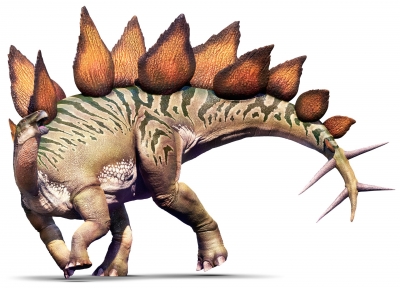
Stegosaurus also had spikes at the end of its flexible tail, which pointed outward from the sides. Scientists began informally calling the spikes thagomizers after a pop culture reference in 1982, when a “Far Side” cartoon showed a group of cavemen calling the sharp spikes thagomizers “after the late Thag Simmons,” according to New Scientist.
Experts think these spikes were used for defense against predators because of two lines of evidence. For one thing, about 10 percent of spikes found are damaged at the tip, Carpenter said. Additionally, scientists have found allosaur fossils (Stegosaurus’s main predator) with puncture wounds from thagomizers.
Stegosaurus’ long skull was pointed and narrow. It had an unusual head-down posture because it had forelimbs that were short in relation to its hind legs.
This leg-length imbalance suggests the dinosaur couldn’t move very fast, because the stride of its back legs would have overtaken its front legs.
Stegosaurus was an herbivore, as its toothless beak and small teeth were not designed to eat flesh and its jaw was not very flexible. Interestingly, unlike other herbivorous, beaked dinosaurs (including Triceratops and the duck-billed Hadrosaurids), Stegosaurus did not have strong jaws and grinding teeth. Instead, its jaws likely only allowed up and down movements, and its teeth were rounded and peglike. It also had cheeks, which gave it room to chew and store more food than many other of dinosaurs.
As a result of its short neck and small head, it most likely ate low-lying bushes and shrubs and other vegetation, including ferns, mosses, cycads, fruits, conifers, horsetails and even fallen fruit. Some scientists believe Stegosaurus could have stood on its hind legs to reach some taller plants, but this idea is debated.
Credit : Live Science
Picture Credit : Google




